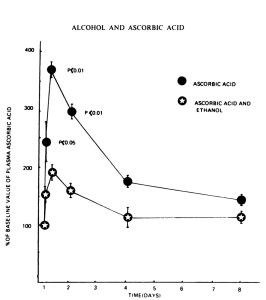Ethanol (alcohol) has been shown to have beneficial health effects in humans. These health effects centre on a protective effect of ethanol on the cardiovascular system. The reason for the protective effects of ethanol are not fully understood, but it is known that for around 24 hours following alcohol ingestion there is a significant decrease in the risk of a myocardial infarction, and this effect likely relates to the effects of ethanol to decrease the aggregation of platelets. These effects are possibly related to the ability of alcohol to alter eicosanoid levels in cells, perhaps by interfering with essential fatty acid metabolism. Although the antioxidants in many drinks also contribute to the health effects of alcohol, there is clear evidence that the ethanol component of alcoholic drinks is protective of cardiovascular disease when used in moderation. However, ethanol also interferes with metabolism in other ways, and in particular may decrease the absorption, and possibly increase the excretion, of a number of vitamins.
The ability of alcohol to decrease tissue levels of thiamine is well known. However, ethanol has also been shown to decrease the plasma levels of vitamin C. For example, in one study1, subject consumed a 2 gram vitamin C supplement with breakfast, with or without 35 grams of ethanol in a glass of water. Fasting concentrations of vitamin C were 7.5 ng/mL at 0900 h before breakfast, and these rose to 26.9 ng/mL by 1500 h in the subjects who consumed no ethanol. In the ethanol group, fasting levels of ascorbic acid were 9.9 ng/mL before breakfast at 0900 h, but levels only rose to 18.9 ng/mL by 1500 h. Therefore the ingestion of ethanol concomitantly with 2 grams of ascorbic acid significantly reduced the plasma levels of the latter. The authors concluded that alcohol may inhibit the absorption of ascorbic acid, although it is possible that the diuretic effects of ethanol may have increased excretion rates. Both groups of subjects showed large increases in plasma levels of ascorbic acid irrespective of ethanol intake (figure 1).

Figure 1. The effects of 35 grams of ethanol on the ascorbic acid levels of healthy subjects following ingestion of breakfast containing 2 grams of ascorbic acid.
RdB
